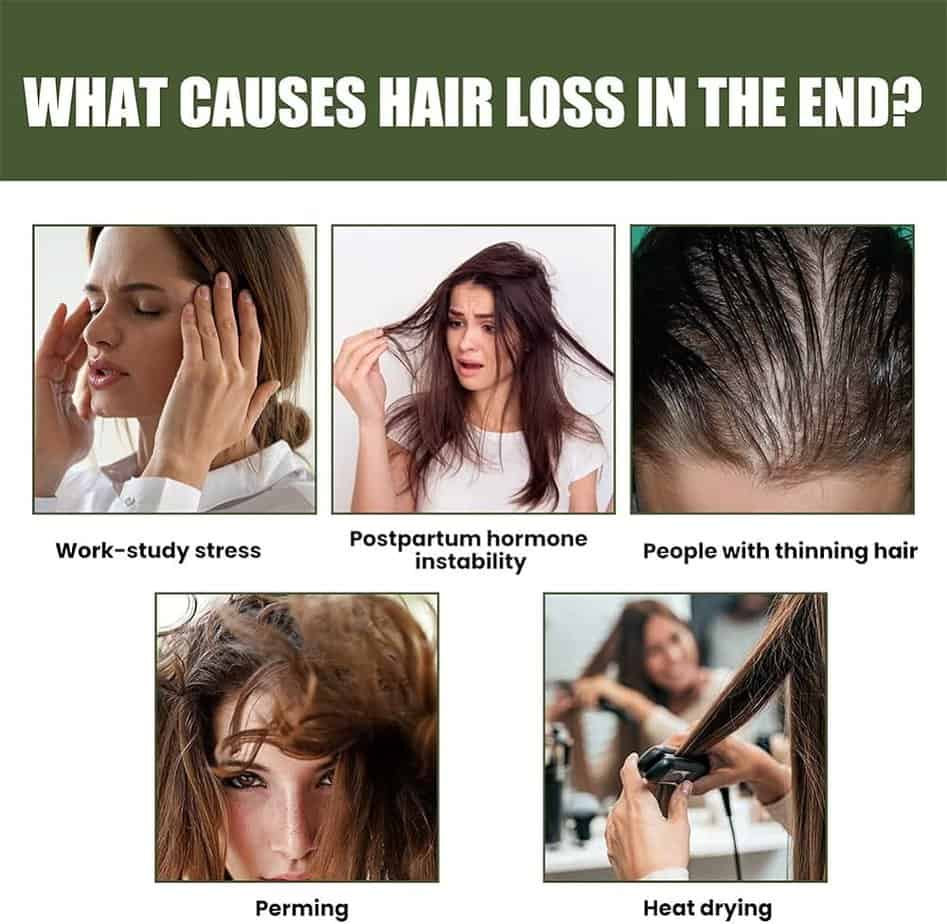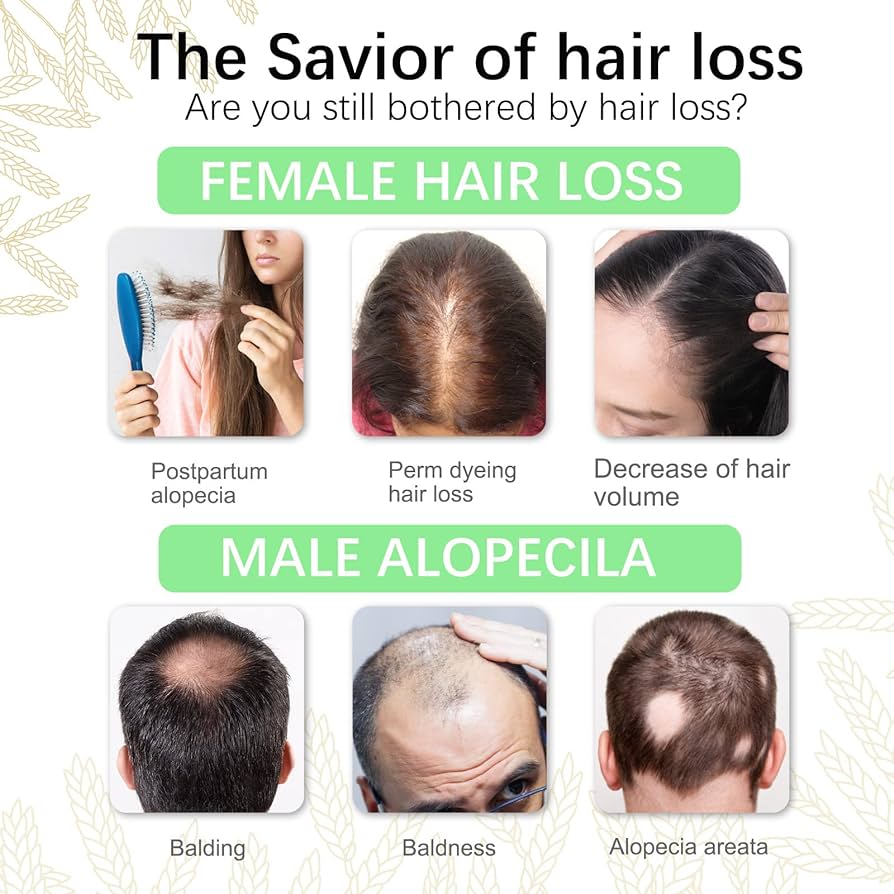Hair Loss Causes:
- Androgenetic Alopecia (Male and Female Pattern Baldness):
- Genetics: Family history plays a significant role in androgenetic alopecia. In men, it’s characterized by a receding hairline and thinning at the crown, while in women, it typically results in overall thinning of the hair.
- Hormonal Factors: Hormones like dihydrotestosterone (DHT) can shrink hair follicles, leading to shorter and finer hair growth cycles.
- Alopecia Areata:
- Autoimmune Response: The immune system mistakenly attacks hair follicles, causing hair to fall out in small, round patches.
- Triggers: Factors such as stress, infections, or environmental triggers can exacerbate symptoms in susceptible individuals.
- Medical Conditions:
- Thyroid Disorders: Both hyperthyroidism and hypothyroidism can disrupt the hair growth cycle, leading to hair loss.
- Hormonal Imbalances: Conditions like polycystic ovary syndrome (PCOS) can cause hormonal imbalances that contribute to hair thinning.
- Scalp Infections: Fungal infections like ringworm can cause hair loss if left untreated.
- Stress:
- Telogen Effluvium: Stressful events, such as surgery, illness, or emotional trauma, can cause a large number of hair follicles to enter the resting phase simultaneously, leading to excessive shedding several months later.
- Nutritional Deficiencies:
- Iron Deficiency: Anemia due to iron deficiency can disrupt the hair growth cycle and lead to hair loss.
- Vitamin D Deficiency: Insufficient vitamin D levels have been associated with hair loss and thinning.

Hair Loss Treatments:
- Medications:
- Minoxidil (Rogaine): Applied topically, minoxidil stimulates hair follicles and prolongs the growth phase of the hair cycle.
- Finasteride (Propecia): This oral medication works by blocking the conversion of testosterone into DHT, thereby reducing hair loss in men with androgenetic alopecia.
- Steroid Injections:
- Localized Treatment: Corticosteroid injections are directly administered into bald patches caused by alopecia areata to suppress the immune response and promote hair regrowth.
- Topical Treatments:
- Corticosteroid Creams: Prescription-strength corticosteroid creams or ointments can be applied to the scalp to reduce inflammation and encourage hair growth.
- Anthralin Cream: Another topical treatment for alopecia areata, anthralin cream, helps regulate the immune response in the affected areas.
- Hair Transplant Surgery:
- Follicular Unit Transplantation (FUT) and Follicular Unit Extraction (FUE): Hair transplant procedures involve harvesting healthy hair follicles from a donor site and implanting them into the balding or thinning areas of the scalp.
- Laser Therapy:
- Low-Level Laser Therapy (LLLT): Devices such as laser combs or helmets emit low-level laser light, which is believed to stimulate hair follicles and promote hair growth.

Prevention and Management:
- Healthy Lifestyle:
- Nutritious Diet: Eat a balanced diet rich in vitamins, minerals, and proteins essential for hair health, including iron, zinc, vitamins A and C, and omega-3 fatty acids.
- Regular Exercise: Physical activity improves blood circulation, delivering essential nutrients to the scalp and promoting hair growth.
- Stress Management: Practice relaxation techniques such as meditation, yoga, or deep breathing exercises to reduce stress levels and minimize the risk of telogen effluvium.
- Scalp Care:
- Gentle Cleansing: Use mild shampoos and avoid harsh chemical products that can strip the scalp of its natural oils.
- Scalp Massage: Massaging the scalp stimulates blood flow and promotes hair growth by nourishing hair follicles.
- Avoidance of Hair Damaging Practices:
- Avoid Tight Hairstyles: Opt for loose hairstyles to prevent traction alopecia caused by constant pulling on the hair follicles.
- Limit Heat Styling: Excessive use of heat styling tools like flat irons and curling wands can damage the hair shaft and lead to breakage.
- Regular Check-ups:
- Medical Evaluation: Schedule regular check-ups with a healthcare provider to monitor overall health and identify any underlying medical conditions contributing to hair loss.
- Dermatologist Consultation: Seek advice from a dermatologist for personalized treatment recommendations and management strategies tailored to your specific hair loss condition.
- Early Intervention:
- Prompt Treatment: Address hair loss symptoms as soon as they arise to prevent further progression and improve treatment outcomes.
- Individualized Approach: Work with healthcare professionals to develop a comprehensive treatment plan based on the underlying cause of hair loss and your individual needs.

In conclusion, a multifaceted approach involving medical intervention, lifestyle modifications, and proper scalp care is essential for managing hair loss effectively. By understanding the underlying causes and implementing appropriate treatment and prevention strategies, individuals can maintain healthy hair and improve their overall well-being. If you’re experiencing significant hair loss or have concerns about your hair health, consult with a healthcare professional for personalized guidance and support.


This website page is phenomenal. The wonderful data shows the essayist’s dedication. I’m shocked and envision more such magnificent posts.
Wow, awesome weblog format! How long have you been running a blog for?
you make running a blog look easy. The overall glance of your website is fantastic,
as smartly as the content! You can see similar here dobry sklep